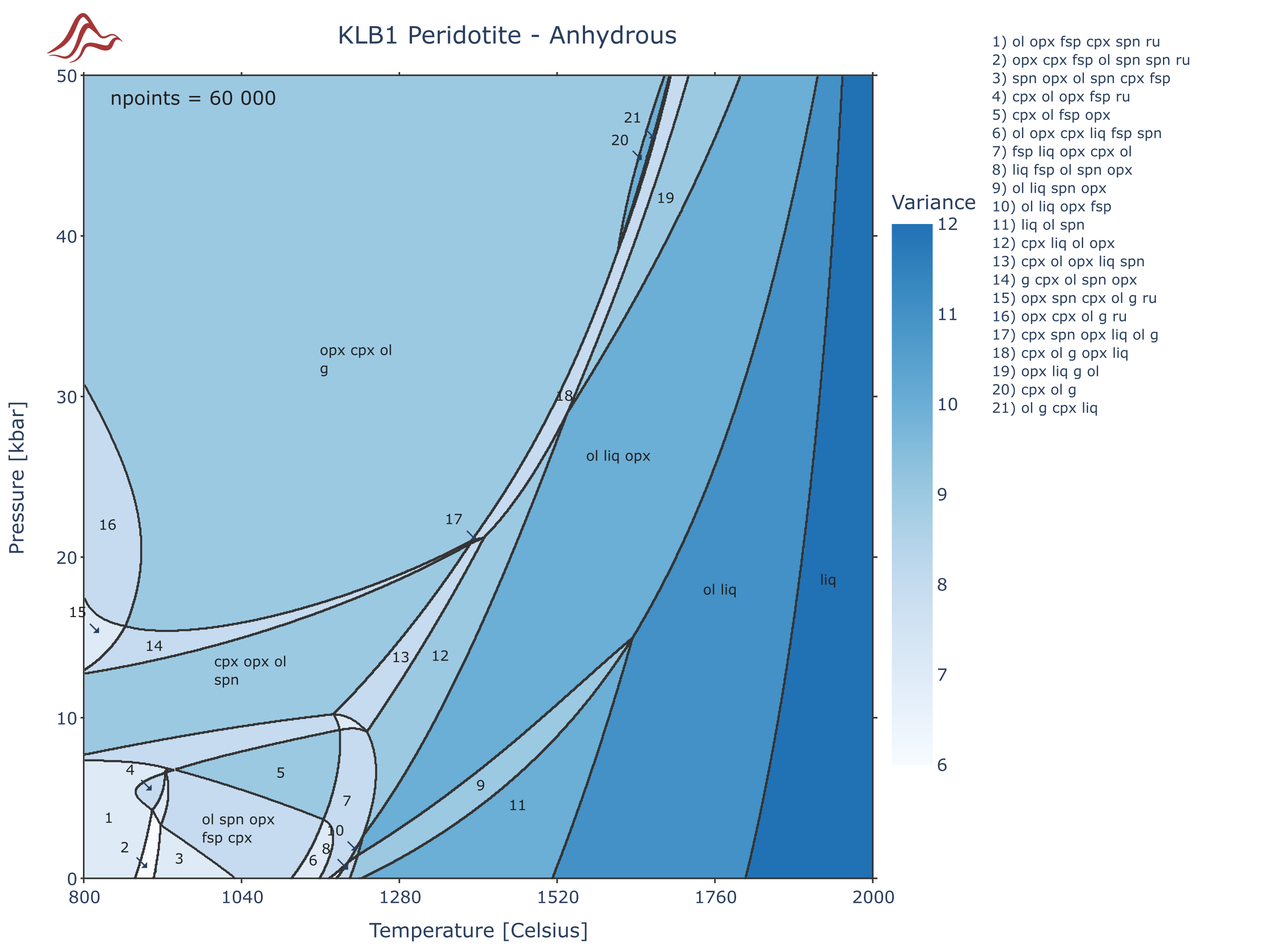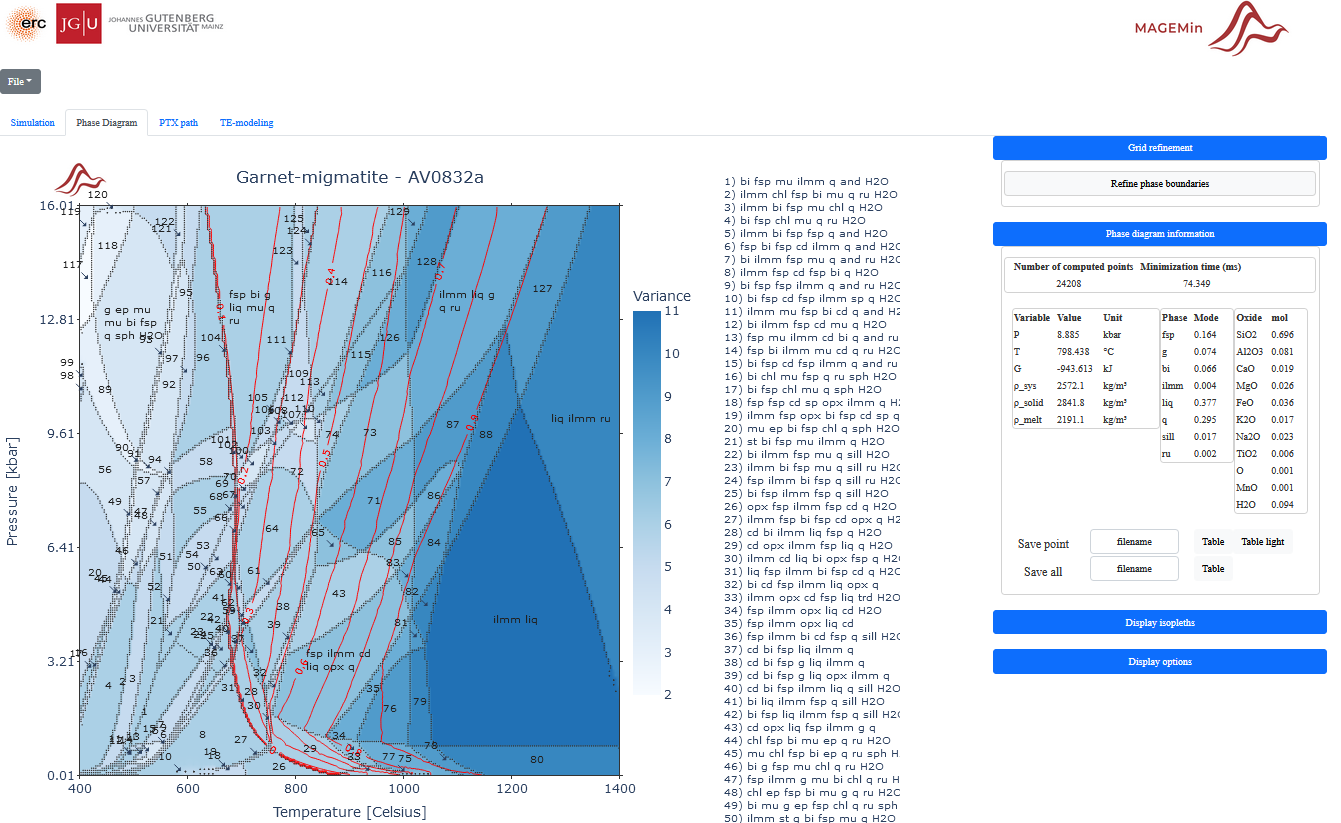Example of auto-labelled isochemical phase diagram for KLB-1 peridotite computed using MAGEMinApp
MAGEMin is a Gibbs energy minimization solver package, which computes the thermodynamically most stable assemblage for a given bulk rock composition and pressure/temperature condition. It also returns parameters such as melt fraction or density, which can be combined with geodynamic/petrological tools to simulate, for example, the evolving chemistry of a crystallising melt.
MAGEMin is written as a parallel C library and uses a combination of linear programming, the extended Partitioning Gibbs free Energy approach and gradient-based local minimization to compute the most stable mineral assemblage. In this, it differs from existing approaches which makes it particularly suitable to utilize modern multicore processors.
While MAGEMin is the engine for the prediction of the stable phases, using it is more convenient through the julia interface MAGEMin_C and/or the web-browser julia app MAGEMinApp.
MAGEMin_C
MAGEMin_C allow to quickly and easily compute single point minimization (serial and parallel) using Julia and retrieve the results in a structure. This gives flexibility to the user on how to treat the data. Some programming experience in Julia are necessary.
MAGEMinApp MAGEMinApp is the graphic user interface developped to compute various type of phase diagrams (P-T, T-X, P-X, PT-X) and PTX paths. MAGEMinApp offers the options to display isocontours, select solution phase for the calculation, automatic labelling of the phase fields, saving the diagrams as vector graphic files and export the data as tables and csv files...
PlotPseudosection
We also provide a MATLAB-based graphical user interface PlotPseudosection.mlapp to compute phase diagrams, PTX paths and trace-element modelling to mafic to ultramafic rocks (MagmaX).
Important
PlotPseudosection is not maintained anymore as the preferred phase diagram tool is now MAGEMinApp.
MAGEMinApp is a web-browser application (see repository) developped in Julia using Dash.jl that relies on MAGEMin_C (which relies MAGEMin) to compute phase diagrams (PT, TX and PX) but also fractional melting and crystallization paths.
To install MAGEMinApp simply do:
julia> ]
pkg> add MAGEMinAppTo run the app:
julia -t 6 # here 6 is the number of used threads. You can adjust the value to your machine to compute the diagrams faster!
julia> using MAGEMinApp
julia> App()
[ Info: Listening on: 127.0.0.1:8050, thread id: 2Then copy and paste the address 127.0.0.1:8050 in your web-browser
Caution
There is some issues with Windows machine (loading Kaleido). ] add MAGEMinApp works well, however when using MAGEMinApp it may hang indefinitely. Currently, the current workaround is to cancel CTRL+C and try using MAGEMinApp a couple of time.
With Matlab using Julia (not maintained anymore)
You can use MAGEMin is through the MATLAB graphical user interface, which has an installation script to download the correct parallel binaries for your system (created using BinaryBuilder & julia).
Follow these steps:
- Download a zip file with the most recent release of
MAGEMin(click on the greenCodebutton @ the top of this page) and unzip it on your machine. - Open the
PlotPseudosectiongraphical user interface from MATLAB (2020+). - Follow the binary installation instructions (which requires you to install a recent julia version).
- After this you are ready to get started, for example by pushing the
Start new computationbutton.
Note that the Matlab GUI is not maintained anymore as the primary phase diagram generator is now the Julia app!
Manual compilation
if you wish, you can also compile MAGEMin yourself, which requires you to install these packages as well:
- MPICH (to allow parallel computations)
- LAPACKE (C version of LAPACK)
- NLopt (https://nlopt.readthedocs.io/)
Details and guidelines are given in the extended documentation: https://computationalthermodynamics.github.io/MAGEMin/index.html
In addition, we make use of uthash and ketopt.
The MAGEMin algorithm is general and can be used with any thermodynamic database that are hardcoded for speed reasons. Presently the igneous (Holland et al., 2018) and the metapelite (White et al., 2014) database are available.
Igneous database
The hydrous mafic melting model of Holland et al. 2018 can be used to simulate the fractional crystallisation from a hydrous basalt to a felsic melt.
The details of this thermodynamic solid solution and endmember database are:
- Holland et al., 2018 (see http://hpxeosandthermocalc.org)
- K2O-Na2O-CaO-FeO-MgO-Al2O3-SiO2-H2O-TiO2-O-Cr2O3 chemical system
- Equations of state for
- Pure stoichiometric phases quartz (q), cristobalite (crst), tridymite (trd), coesite (coe), stishovite (stv), kyanite (ky), sillimanite (sill), andalusite (and), rutile (ru) and sphene (sph).
- Solution phases spinel (spn), biotite (bi), cordierite (cd), clinopyroxene (cpx), orthopyroxene (opx), epidote (ep), garnet (g), hornblende (hb), ilmenite (ilm), silicate melt (liq), muscovite (mu), olivine (ol), ternary feldspar (pl4T), and aqueous fluid (fl).
Metapelite database
The metapelitic model (extended with MnO, White et al., 2014) allows to compute the mineral assemblage from low temperature to supra-solidus conditions.
- Added March 2023,
MAGEMin v1.3.0 - White et al., 2014a, 2014b (see http://hpxeosandthermocalc.org)
- K2O-Na2O-CaO-FeO-MgO-Al2O3-SiO2-H2O-TiO2-O-MnO chemical system
- Equations of state for
- Pure stoichiometric phases quartz (q), cristobalite (crst), tridymite (trd), coesite (coe), stishovite (stv), kyanite (ky), sillimanite (sill), andalusite (and), rutile (ru) and sphene (sph).
- Solution phases spinel (spn), biotite (bi), cordierite (cd), orthopyroxene (opx), epidote (ep), garnet (g), ilmenite (ilm), silicate melt (liq), muscovite (mu), ternary feldspar (pl4T), sapphirine (sa), staurolite (st), magnetite (mt), chlorite (chl), chloritoid (ctd) and margarite (ma).
Ultramafic thermodynamic dataset
- aadded May 2023,
MAGEMin v1.3.2 - Evans & Frost, 2021 (see http://hpxeosandthermocalc.org)
- SiO2-Al2O3MgO-FeO-O-H2O-S chemical system
- Equations of state for
- Pure stoichiometric phases quartz (q), cristobalite (crst), tridymite (trd), coesite (coe), stishovite (stv), kyanite (ky), sillimanite (sill), pyrite (pyr)
- Solution phases fluid (fluid), olivine (ol), brucite (br), antigorite (atg), garnet (g), talc (t), chlorite (chl), spinel (spi), orthopyroxene (opx), pyrrhotite (po) and anthophylite (anth)
- added May 2023
Metabasite thermodynamic dataset
- Added October 2023,
MAGEMin v1.3.5 - Green et al., 2016 (see http://hpxeosandthermocalc.org)
- K2O-Na2O-CaO-FeO-MgO-Al2O3-SiO2-H2O-TiO2-O chemical system
- Equations of state for
- Pure stoichiometric phases quartz (q), cristobalite (crst), tridymite (trd), coesite (coe), stishovite (stv), kyanite (ky), sillimanite (sill), andalusite (and), rutile (ru) and sphene (sph).
- Solution phases spinel (sp), biotite (bi), orthopyroxene (opx), epidote (ep), garnet (g), ilmenite (ilm), silicate melt (liq), muscovite (mu), ternary feldspar (pl4T), chlorite (chl), Omphacite(omph) and Augite(aug).
Please keep in mind that the datasets are only calibrated for a limited range of P,T and bulk rock conditions. If you go too far outside those ranges, MAGEMin (or most other thermodynamic software packages for that matter) may not converge or give bogus results.
Developing new, more widely applicable, thermodynamic datasets is a huge research topic, which will require funding to develop the models themselves, as well as to perform targeted experiments to calibrate those models.
Full support to install and use MAGEMin is available here.
An open-acces paper describing the methodology is:
- Riel N., Kaus B.J.P., Green E.C.R., Berlie N., (2022) MAGEMin, an Efficient Gibbs Energy Minimizer: Application to Igneous Systems. Geochemistry, Geophysics, Geosystems 23, e2022GC010427 https://doi.org/10.1029/2022GC010427
If you use the software, we really appreciate if you cite this study. We also appreciate stars (see the top of this page).
You are very welcome to request new features and point out bugs by opening an issue (top of this page). You can also help by adding features and creating a pull request.
Development of this software package was funded by the European Research Council under grant ERC CoG #771143 - MAGMA.



